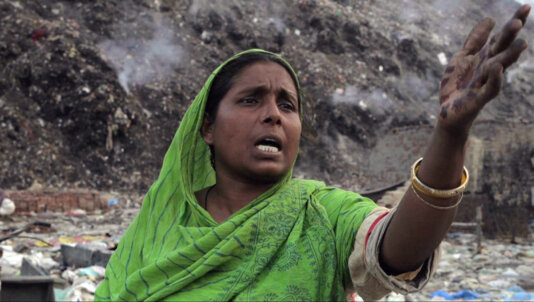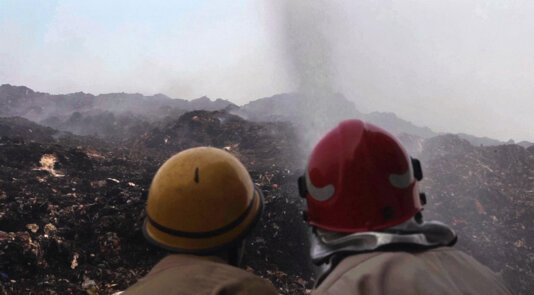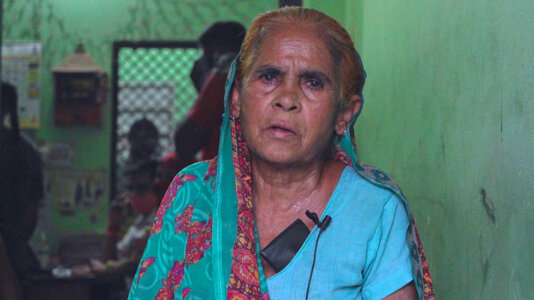- About
- Topics
- Picks
- Audio
- Story
- In-Depth
- Opinion
- News
- Donate
-
Signup for our newsletterOur Editors' Best Picks.Send
Read, Debate: Engage.
| June 02, 2022 | |
|---|---|
| topic: | Health and Sanitation |
| tags: | #India, #landfills, #unsegregated waste, #pollution, #health crisis, #Delhi |
| located: | India |
| by: | Hanan Zaffar, Danish Pandit |
It has been almost a month since Dilwara Begum (31) witnessed huge garbage humps in Delhi’s Bhalswa landfill site catch fire. Begum, a rag picker who along with her family makes a living by rummaging through the 70-acre landfill to collect scrap, feels that the smoke emanating from the enormous mound of garbage would soon suffocate her family to death.
"These flames just don’t seem to stop. It seems the site is going to burn for eternity. There was a fire last year, too, but this year it is of a magnitude I have never seen before," Begum told FairPlanet.
In one of their longest operations to date, firefighters in the area have been trying to douse the smouldering fires at the landfill site since 26 April. Their efforts have managed to contain the flames, but the fires appear to be far from over.
The smoke emanating from the site has worsened an already severe air quality crisis in Delhi, particularly in areas surrounding the landfills, where residents are struggling to breathe.
"Our children are nauseated. They vomit all today. Almost all the residents are complaining of stomach aches," said Nandi Devi (65), who lives in Bajrang Chowk, an area in the vicinity of the Bhalswa landfill site.
Devi’s son Anuj is currently undergoing treatment for several respiratory tract infections.
"Our eyes are burning. It is getting unbearable to breathe. We are gasping for fresh air. It feels like a silent death," Devi told FairPlanet while waiting for her son’s turn outside a medical clinic in the area.
Delhi produces close to 10,000 tonnes of waste each day, which get dumped at three major landfill sites that operate way beyond their capacity. Bhalswa is one of these landfills.
Experts claim the fires are caused by a combination of poor handling and disposal of waste and the unrelenting heat wave that saw many parts of the capital hit by record breaking temperatures of 49°C (120°F) this May. Methane gas released from decaying matter in these sites catches fire due to the increasing temperatures.
A major landfill in Delhi's Ghazipur suburb is also up in flames.
Delhi ranks as the world’s most polluted capital city, and the landfill sites' fires are worsening its already poor air quality. In late May, the Value of Air Quality Index (AQI) for various places in Delhi hovered around 300, a level considered "hazardous" by the US government's Environmental Protection Agency (EPA). Such level of air pollution, the EPA maintains, could trigger "health warnings of emergency conditions," for the entire population.
"I would say it is beyond an environmental crisis. Such severe air pollution is a public health emergency," Prerna Singh Bindra, a leading environmentalist based in New Delhi, told FairPlanet.
Singh Bindra said that the government is becoming increasingly insensitive to the deterioration of air quality in the capital and the adverse health impacts it has on the population.
"Even as we face severe air pollution, the government is diluting environmental laws, cutting trees on a massive scale and undertaking massive construction projects - one example of which is the redevelopment of Central Vista," Singh Bindra said, referring to the rebuilding of India’s central administrative area in New Delhi.
A recent report revealed that officials in the Delhi region have sanctioned the cutting of more than 60,000 trees between 2015 and 2021 in order to clear space for infrastructure projects like the building of roadways, official buildings and a fast train service.
"[Air pollution] has reached levels never seen before. I am seeing an unprecedented rush of people complaining about breathing issues from the last month or so," Dr Jibchh Sahu, who runs a clinic in the vicinity of the Bhalswa landfill, told FairPlanet.
Due to the dumping of solid wastes, groundwater in areas near the landfills is also severely contaminated, with high traces of chlorine and sulphates. When consumed by locals, this water causes several gut and skin-related issues.
"People are not only complaining about breathing problems, but also stomach aches. A large number of people are getting diarrhoea and dysentery. Many kids in the area are complaining about a strange nausea," said Dr Sahu.
"Exposure to toxic air is also leading to eye-related problems," he added.
As per a study conducted by LocalCircles, a community platform based in Delhi, 80 percent of families in the city have at least one member suffering from pollution-related ailments; of those, 48 percent are directly affected by air pollution.
Air pollution is also one of the top risk factors for pre-mature deaths in India. Of the 2.3 million people in the country who died of pollution in 2019, 73 percent died because of poor air quality, as per a Lancet study.
Even as the city battles with pollution, some environmentalists appear hopeful about tackling the crisis through afforestation. Various afforestation efforts by the government and non-governmental organisations have led to a sgnificant increase in the vegetative cover of the city.
According to the India’s Environment Ministry, over the last two years the green cover of Delhi has increased from 21.88 percent to 23.06 percent of its geographical area.
"Planting trees is a very viable option. The moment you have appropriate green cover, what happens is that any type of pollution gets absorbed," said Swami Prem Parivartan, founder of the GiveMeTrees Trust, which has planted more than 1.5 million trees in Delhi.
Parivartan believes that the planting of trees would also solve the crisis of contaminated groundwater in Delhi, especially near landfill sites.
"Trees are magnets for water. They will bring water from the water table and not let the water table go down. They are the best and the most natural and the lowest cost, most effective, highest technology water-harvesting method."
Image by Danish Pandit




By copying the embed code below, you agree to adhere to our republishing guidelines.
